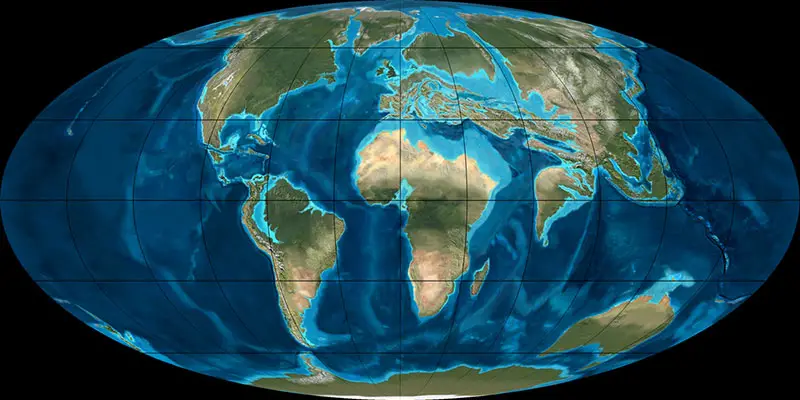†Vastanomys (Omomyidae)
Vastanomys ist eine Primatengattung innerhalb der Familie Omomyidae, deren 3 Mitglieder ab dem frühen Paläogen (Eozän) im Ypresium lebten, das vor ungefähr 56 Millionen Jahren begann und bis vor 47,8 Millionen Jahren andauerte. Viele Überreste wurden in Indien gefunden.
Vastanomys heißt eine ausgestorbene Primatengattung, zu der man zwei Arten zählt, die im frühen Eozän in Indien verbreitet waren.
Die Funde stammen aus der Cambay Shale Formation Indiens und sind zwischen 55,8 und 48,6 Millionen Jahre alt.
Vastanomys gracilis
Das Typusexemplar mit der Bezeichnung IITR/SB/VLM 771 ist ein Unterkiefer mit Gebissfragmenten und dem zweiten Backenzahn (m2). Der Fund stammt aus der Cambay Shale Formation und ist zwischen 55,8 und 48,6 Millionen Jahre alt. Vastanomys gracilis war vermutlich ein baumlebender Insektenfresser.
| Sammlung | Kommentar zum Fundort | Epoche, Alter | Geologie, Formation |
|---|---|---|---|
| Vastan Lignite Mine | Cambay Shale | ||
| Kommentar z. Stratigraphie | Lithographie | Kommentar z. Taxonomie | |
| age based on Nummulites burdigalensis, which implies Shallow Benthic Zone 10 according to Bajpai et al, and SBZ 10-11 according to Rose et al. most small and large mammals are from two different, immediately superposed beds above Lignite 2 and at the base of the estuarine cycle 1, low in the section, but additional mammals are from supratidal deposits well above the highest lignite at the top of cycle 6 (Rose et al. 2009) | alternate dark grey carb. shale & greenish black shale/marl or (according to Rose et al. 2006) "dark, organic-rich, clayey silt at the contact between a marine shelly layer, containing shark and fish remains, and a continental clay layer" or (according to Rose et al. 2009) "smaller terrestrial vertebrates... come from a thin lens (<0.5 m thick) of dark, clayey silt and shale with abundant plant matter... Approximately 1-2 m higher is a dark clay zone that has produced larger mammals" | Rose et al. list four insectivores sensu lato that may or may not be the same as those described by Bajpai et al.: ? Cimolestidae (said to be new), ? Adapisoriculidae (said to be new), a larger insectivore, and ? Erinaceomorpha |
| Physiologie | |
|---|---|
| Gewicht: | ? |
| Schwestertaxa | |
Vastanomys major
Das Typusexemplar mit der Bezeichnung GU/RSR/VAS 1541 ist ein rechter unterer Backenzahn. Die Morphologie des Zahnes deutet darauf hin, dass Vastanomys major ein baumlebender Insektenfresser war.
| Sammlung | Kommentar zum Fundort | Epoche, Alter | Geologie, Formation |
|---|---|---|---|
| Vastan Lignite Mine | Cambay Shale | ||
| Kommentar z. Stratigraphie | Lithographie | Kommentar z. Taxonomie | |
| age based on Nummulites burdigalensis, which implies Shallow Benthic Zone 10 according to Bajpai et al, and SBZ 10-11 according to Rose et al. most small and large mammals are from two different, immediately superposed beds above Lignite 2 and at the base of the estuarine cycle 1, low in the section, but additional mammals are from supratidal deposits well above the highest lignite at the top of cycle 6 (Rose et al. 2009) | alternate dark grey carb. shale & greenish black shale/marl or (according to Rose et al. 2006) "dark, organic-rich, clayey silt at the contact between a marine shelly layer, containing shark and fish remains, and a continental clay layer" or (according to Rose et al. 2009) "smaller terrestrial vertebrates... come from a thin lens (<0.5 m thick) of dark, clayey silt and shale with abundant plant matter... Approximately 1-2 m higher is a dark clay zone that has produced larger mammals" | Rose et al. list four insectivores sensu lato that may or may not be the same as those described by Bajpai et al.: ? Cimolestidae (said to be new), ? Adapisoriculidae (said to be new), a larger insectivore, and ? Erinaceomorpha |
Literatur
S. Bajpai, V. V. Kapur, J. G. M. Thewissen, D. P. Das, B. N. Tiwari, R. Sharma, N. Saravanan 2005, Early Eocene primates from Vastan Lignite Mine, Gujarat, western India. Journal of the Palaeontological Society of India. 50:2, p. 43 - 54K. D. Rose, R. S. Rana, A. Sahni, K. Kumar, P. Missiaen, L. Singh, T. Smith 2009, Early Eocene primates from Gujarat, India. Journal of Human Evolution. 56:4, p. 366 - 404, DOI: 10.1016/j.jhevol.2009.01.008
